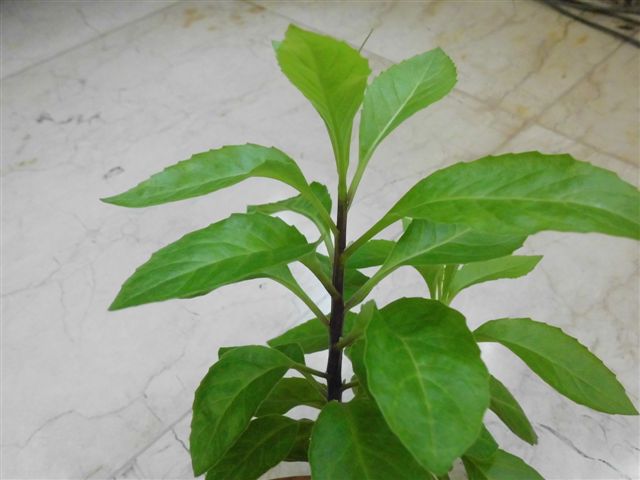Gynura procumbens - Diabetes Plant, Plant of Longevity, Sambung & Insulin Plant
Couldn't load pickup availability
DIABETES PLANT
(1mEdABCD) Gynura procumbens. A reknowned reputation as a blood balancer. Reports are that if Diabetics eat 6-12 leaves a day they will no longer require insulin. Diabetes Plant is reputed to have other medicinal values like lowering cholesterol, lowering blood pressure and inhibiting cancer cells. Diabetes Plant tastes fine and can be eaten raw, in smoothies, salads and stir fries. Good in a tea. Fast growing in all areas....fleshy leaved evergreen. Full sun light shade. These plants will not continue to grow in cold areas in winter but will not die, so if you have them in winter just maintain them and keep them dry until they will grow in spring.
.....Priced at $10.90 each or 3 for $29 or 5 for $39
NB Gynura procumbens contains asparaginase which is an enzyme that lowers acrylamides in the body....acrylamides are cancer causing substances.
Scientific review, follow the link https://www.frontiersin.org/articles/10.3389/fphar.2016.00052/full
We have a further article(2010) written by Isabelle Shiphard on Diabetes Plant. See below.
The name Sambung means 'life extender'...
SAMBUNG (Gynura procumbens)
In the last few weeks I have had the opportunity to do further research on the herb Sambung, which I mentioned briefly in Newsletter No. 1.
Sambung has had numerous common names including: Mollucan Spinach, Leaves of the Gods, Sambung Nyawa which means 'extending life' (Malay), Daun Dewa, Bai Bing Ca (Chinese).
Sambung
It is a hardy perennial, of the Asteraceae family to which daisies belong, and includes many plants useful to man, eg. German chamomile, echinacea, sunflower, calendula, dandelion and St. Mary's thistle.
The bush may grow 30cm to 100 cm tall, and staking the plant is an advantage as the oval-shaped leaves to 10cm long have a rather thick, fleshy feel, and can weigh, down the stems. The stems are green, and may get tinges of purple, and the leaves may also have purple colourings. Orange flowers are similar in size and form to milk thistle flowers (Sonchus oleraceus). Sambung can be propagated from seeds and cuttings, and could be grown in a bucket-size pot or in the garden. Here at Nambour, in South East Queensland's sub-tropical conditions, plants like a little shade. In cold and temperate climates, the plant possibly would need to be treated as an annual, with seed saved for planting the next season.
The plant is well known in South East Asia, with folklore medicinal uses in China, Indonesia, Malaysia and Thailand, and the leaves of the plant are also eaten as a vegetable. Leaves have a mild flavour (some people say far better than spinach as a vegetable, while others say the leaves taste like green beans) and can be used raw in salads, added to soups, stir-fries, casseroles, condiments and sauces, rice dishes and other savoury meals. And when growing very well, and leaves are in excess, feed some to laying hens, or grow some plants in a poultry forage system.
Sambung Leaves
Many people just make it "a way of life" to eat 2-3 leaves a day, for the many benefits to health the plant may provide.
Leaves can be made as a herbal tea using 5-10 cut up leaves to 1 cup of boiling water, stir and leave to steep 5 minutes, drink hot or cool. The flavour is quite pleasant. Other herbs can be added to the tea if desired, like peppermint, lemon myrtle, citronella grass, etc. Leaves (bruised or placed in boiling water to soften them) are applied externally as a poultice, or made into a salve for numerous skin conditions.
The herb has been noted for anti-viral, anti-inflammatory, anti-histamine, anti-pyretic, anti-oxidant, anti-cancer, anti-ageing, anti-allergy properties, and also actions as a blood cleanser, tonic, diuretic and pain killer. Some of its uses include: treating migraines, dyspepsia, constipation, arthritis, rheumatism, diabetes, dysentery, fevers, malaria, varicose veins, kidney stones, joint and back pain, knitting broken bones and strengthening ligaments, stroke and cardiovascular conditions, high cholesterol, lymphatic diseases, cancers, leukaemia, hepatitis, detoxifier, coughs, colds, sore throats, halitosis, laryngitis, flu, sinusitis, depression, urinary infections, renal failure, varicose veins, and as a "skin-care-elixir" for skin diseases, skin care and toning, acne, boils, bites. It supports male reproductive health and performance, including prostate function. Females have taken the herb for breast firming, menstrual cycle problems, and vagina contraction.
I came to hear of this herb from a man who called at the Herb Farm several years ago, who told me of his friend of 84 years, who had taken the leaves as a tea. He said, "His friend when 70 years of age was diagnosed with prostate cancer. He heard about the herb a few years after his cancer diagnosis and started taking the tea, and completely cleared prostate cancer. He has kept up taking the herb (5 years now), and today he looks like a man of 60." He made the tea with 9 large leaves, finely cut, placed in a saucepan with 2 cups of water, and brought to a low simmer for 2 minutes. The liquid was strained and drunk either hot or cool.
Many people from South East Asia know the herb as 'life extender'. Fred who visited the Herb Farm asking for the Sambung plant to grow, told me of his aged aunt, who started taking Sambung daily since 1988 as she had been diagnosed with kidney and bladder cancer, and 20 years later Fred said, she is still alive and active; a 'life extender' for Fred's aunt.
Sambung contains asparaginase. Asparaginase is an enzyme that has been found to lower levels of acrylamides in the body. Researchers say, acrylamides are seen as cancer causing substances, that are created when some foods are fried, baked, grilled or roasted. Acrylamides have also been found in foods, grown on mineral deleted soils.
The addition of asparaginase to foods is one strategy to lower acrylamide levels in foods, and this is where Sambung comes in by eating a few leaves daily, we provide a natural source of asparaginase. Any herb, a nature s remedy, that we can grow and use regularly for well-being, is most worthwhile.
Research has shown that it is an efficient regulator of blood sugar, and that the herb is also found to protect the kidneys, and also retinas, from damage caused by high blood sugar. It also lowers blood pressure, cholesterol and triglycerides, and has anti-inflammatory and antiviral action. Diabetics who use the herb have experienced very satisfying results in lowering glucose levels, and normalising the blood sugar.
Now for non-diabetics, it is said, the herb does not have this lowering glucose level affect, and it is interesting, that, non-diabetics are able to get the other therapeutic benefits of Sambung without the danger of having their blood sugar levels manipulated below normal levels.
Sambung is one more herb, I have had a chance to get to know, for many benefits to our well-being; another good 'all-rounder-herb' for our gardens and health benefits.


